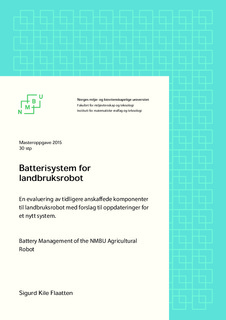| dc.description.abstract | Denne oppgaven handler om en landbruksrobot som ble bygd av fem mastergradsstudenter våren 2014 ved Norges miljø- og biovitenskapelige universitet. Bakgrunnen for å lage roboten er å øke bærekraften i landbruket ved å benytte seg av mindre og lettere maskiner enn traktorer og annen tung redskap som brukes i dag. Denne roboten bruker batterier som energiforsyning, og kan dermed bruke elektrisk energi der traktoren er nødt til å benytte seg av diesel. Roboten skal være en lett landbruksmaskin som skal kunne benytte seg av diverse verktøymoduler for å utføre forskjellige oppgaver i felt uten overoppsyn.
Utviklingen av roboten våren 2015 inkluderer design og produksjon av forskjellige verktøymoduler som roboten skal kunne ta i bruk ute på jordet, samt evaluering og oppdatering av batterisystemet som per nå forsyner roboten med energi.
I denne oppgaven har ett av to batterier som utgjør batterisystemet til roboten blitt undersøkt, da det ble fryktet at dette batteriet kunne være ødelagt på grunn av dyputladning. Undersøkelsene av dette batteriet besto blant annet av en utladningstest over omtrent fem timer, hvor batteriet ved en utladningsstrøm på snaue seks ampere viste til en kapasitet på 30,2 amperetimer. Batteriene skal i utgangspunktet ha en kapasitet på 30 amperetimer. Frykten viste seg derfor å være ubegrunnet; batteriet har fortsatt kapasitet nok til å kunne brukes for å drive roboten.
Batteristyringssystemet som opprinnelig fulgte med i de originale batteripakkene viste seg derimot å ikke være tilfredsstillende. En billig 'protector'-BMS satt innebygd i batteripakken som ble åpnet opp, og det viste seg at denne ikke hadde de nødvendige funksjonene for å optimalisere kapasiteten til batteripakken. Noe som er viktig om roboten skal bidra til å minske utslippene fra landbruket generelt. Dermed har det blitt gått til innkjøp av nye 'protector'-BMSer, men disse er heller ikke noen god løsning på lengre sikt, da de uten varsel vil kunne bryte strømmen ut av batteriet, og dermed slå av hele systemet i kritiske situasjoner. En oppdatering til et nytt batterisystem bør bestå av batteripakker som kan kommunisere med resten av systemet slik at det oppnås bedre kontroll av cellene til enhver tid. Robuste LiFePO4 erstatningsbatterier for blybatterier ser ut som en god, men dyr, oppdatering.
ABSTRACT: This paper is about an agricultural robot, which was build by five master's degree students during the spring of 2014 at the Norwegian University of Life Sciences. The purpose of this robot is to increase the sustainability in agriculture by utilizing smaller and lighter machinery than the tractors and other heavy equipment currently in use. This robot is powered by batteries, and hence, is able to use electrical energy, whereas the tractor relies entirely on diesel fuel. The robot is supposed to be a light agricultural machine which performs different tasks autonomously in the field by utilizing specially made tools.
The developement of the robot during the spring of 2015 includes design and production of different specialized tools which the robot can use in the field, as well as evaluation and updates of the battery system, which is currently providing the robot with energy.
During this paper, one out of two batteries, which constitutes the battery system of this robot, was examined because it was suspected that the battery might have sustained some damage due to an overdischarge. The examinations of this battery consisted, amongst other things, of a discharge test over the course of five hours, where the battery delivered a capacity of 30,2 amp-hours, with a discharge current of almost six amps. The batteries are supposed to have a name plate capacity of 30 amp-hours. Therefore, it is safe to assume that the battery still contains enough capacity to be able to power the robot.
The original battery management system, on the other hand, was not satisfactory. A cheap protector was build into the battery pack which was opened up, and it became apparent that the protector didn't contain the necessary functionality to optimize the capacity of the battery pack. This is an important feature, if the robot is to succed in it's goal to minimize the emissions from agricultural use, in general. For this reason, a new protector has been purchased. This is, however, not a good long-term solution, because these protectors might turn off the battery current without warning, thereby shutting down the entire system during critical situations. An update to this battery system should contain battery packs with the ability to communicate with the rest of the control system of the robot, thereby maintaing a maximum of control of the battery cells at any time. Rugged, LiFePO4 lead-acid replacement batteries seems to be a good, yet expensive, solution. | nb_NO |

